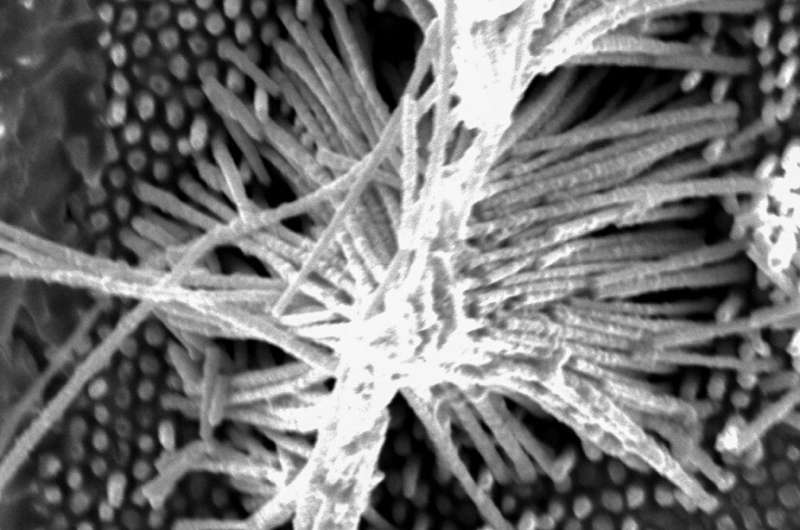Molding of nanowires spurs unanticipated phases

Sometimes to make big breakthroughs, you have to start very small.
One way that scientists can get the most out of certain quantum materials is by fabricating nanoscale structures that generate new properties at the material’s surfaces and edges. Cornell researchers used the relatively straightforward process of thermomechanical nanomolding to create single-crystalline nanowires that can enable metastable phases that would otherwise be difficult to achieve with conventional methods.
“We’re really interested in this synthesis method of nanomolding because it allows us to make many different kinds of materials into nanoscale quickly and easily, yet with some of the control that other nanomaterial synthesis methods lack, particularly control over the morphology and the size,” said Judy Cha, professor of materials science and engineering in Cornell Engineering, who led the project.
The team’s paper, “Nanomolding of Metastable Mo4P3,” published April 12 in Matter. The paper’s lead author is postdoctoral researcher Mehrdad Kiani.
In thermomechanical nanomolding, a material is consolidated into a bulk feedstock, put into a porous mold and pressed at high temperatures for several hours. The resulting structure is then separated from the feedstock—in this case, by ultrasound vibrations, a process known as sonication—and deposited on a silicon wafer or other surface.
The benefit of this process is that nanoscale amounts of solid materials can be molded at temperatures well below their melting point, representing easy processing conditions. This enables a wide range of materials to be leveraged for untapped exotic properties, similar to the way that graphene has revolutionized conduction in electronics.
Cha’s team has been experimenting with molybdenum monophosphide (MoP), which is a topological compound.
“Topological metals are predicted to have decreasing resistance as you go to smaller sizes, and MoP is not only topological but also has a really high carrier density (electrons per volume), which should further help bring the resistance down,” Kiani said.
Cha and her team have previously shown that nanomolding of topological nanowires could accelerate the discovery of new electrical properties for applications such as quantum computing, microelectronics and clean-energy catalysts. These nanowires would be particularly well-suited for being interconnects between the billions of transistors in integrated circuits.
Earlier this year, the group demonstrated that MoP nanowires had such low resistivity, they outperform copper interconnects.
“That was a surprising discovery,” Cha said. “But the challenge was, we needed to continue to make MoP smaller and smaller, and the methods that we’ve been using just weren’t getting us there. So, then along came a nanomolding method, and we saw it as a way to make even smaller MoP nanowires to continue to check whether the resistivity is going to be still much lower than copper.”
Instead, they found the nanowire molding process converted a crystal structure of MoP into a different composition: Mo4P3.
“That was not something we expected. And even more surprising was that this phase Mo4P3 is not a stable phase that you normally get,” Cha said. “Now we realize that this molding method can potentially get us metastable phases.”
The metastable Mo4P3‘s resistivity was about 75% higher than MoP’s, so MoP still remains the most promising candidate for interconnects.
“This really broadens our exploration space for new materials. And who knows what the possibilities may be?” Cha said. “When graphene was first discovered, it was not at all clear that we could use it in a golf ball, for example, to think about a mundane application. For now, we want to find the next example of Mo4P3, another metastable phase that we can arrest and then make it into nanowires.”
More information:
Mehrdad T. Kiani et al, Nanomolding of metastable Mo4P3, Matter (2023). DOI: 10.1016/j.matt.2023.03.023
Citation:
Molding of nanowires spurs unanticipated phases (2023, April 20)
retrieved 20 April 2023
from https://phys.org/news/2023-04-molding-nanowires-spurs-unanticipated-phases.html
This document is subject to copyright. Apart from any fair dealing for the purpose of private study or research, no
part may be reproduced without the written permission. The content is provided for information purposes only.
For all the latest Science News Click Here
For the latest news and updates, follow us on Google News.

